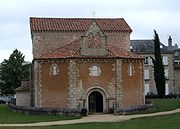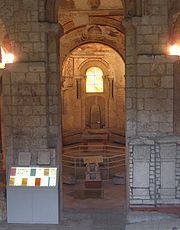
Baptistère Saint-Jean
Encyclopedia

Baptistery
In Christian architecture the baptistry or baptistery is the separate centrally-planned structure surrounding the baptismal font. The baptistry may be incorporated within the body of a church or cathedral and be provided with an altar as a chapel...
of St. John) is a religious edifice in Poitiers
Poitiers
Poitiers is a city on the Clain river in west central France. It is a commune and the capital of the Vienne department and of the Poitou-Charentes region. The centre is picturesque and its streets are interesting for predominant remains of historical architecture, especially from the Romanesque...
, France
France
The French Republic , The French Republic , The French Republic , (commonly known as France , is a unitary semi-presidential republic in Western Europe with several overseas territories and islands located on other continents and in the Indian, Pacific, and Atlantic oceans. Metropolitan France...
. It is reputed to be the oldest existing Christian
Christianity
Christianity is a monotheistic religion based on the life and teachings of Jesus as presented in canonical gospels and other New Testament writings...
building in France and one of the most prominent examples of Merovingian architecture
Merovingian art and architecture
Merovingian art and architecture is the art and architecture of the Merovingian dynasty of the Franks, which lasted from the 5th century to the 8th century in present day France, Benelux and a part of Germany....
.
Roman origins
The central part of the building was constructed around 360, atop the substructures of Roman buildings that were demolished in 276, in what subsequently became the episcopal quarter of the town of Poitiers, near the residence of Saint HilaryHilary of Poitiers
Hilary of Poitiers was Bishop of Poitiers and is a Doctor of the Church. He was sometimes referred to as the "Hammer of the Arians" and the "Athanasius of the West." His name comes from the Latin word for happy or cheerful. His optional memorial in the Roman Catholic calendar of saints is 13...
and the future cathedral. Many changes have been made to the original structure. A baptismal tank
Baptismal font
A baptismal font is an article of church furniture or a fixture used for the baptism of children and adults.-Aspersion and affusion fonts:...
was added in the 6th century, as at that time baptism
Baptism
In Christianity, baptism is for the majority the rite of admission , almost invariably with the use of water, into the Christian Church generally and also membership of a particular church tradition...
was conducted by total immersion.
Early Middle Ages and Reconstruction
The building was badly damaged during the Visigoth occupation in the fifth century. A restoration was begun after Clovis I defeated Alaric II in 507 at the Battle of Vouillé, near Poitiers. This restoration included the repair of the upper parts of the walls of the cella, the addition of three apsidioles in the form of a transept and an apse, and the decoration of outside and inside of the building..jpg)
Catechumen
In ecclesiology, a catechumen , “‘down’” + ἠχή , “‘sound’”) is one receiving instruction from a catechist in the principles of the Christian religion with a view to baptism...
ts of both sexes), the lateral apsidioles, the arms of the transept, were rebuilt as apses, and the square narthex was given its present polygonal shape. It was around this time that baptism by immersion had been abandoned as a practice by the Catholic Church, and subsequently, the baptismal pool was filled in and replaced by baptismal fonts. The baptistery then became a parish church.
High period of the Late Middle Ages
From the twelfth to fourteenth century, the church was embellished by frescoes which are still visible today. They include representations of Christ's ascension, symbolic peacocks, horsemen with flowing cloaks, one of which represents Emperor Constantine, and a bust of the Holy Virgin.Modern times

French Revolution
The French Revolution , sometimes distinguished as the 'Great French Revolution' , was a period of radical social and political upheaval in France and Europe. The absolute monarchy that had ruled France for centuries collapsed in three years...
, and was confiscated from the church and sold as national property to a private citizen who used it as a warehouse. It was saved from demolition by a public subscription which allowed it to be repurchased in 1834. The baptistery underwent restoration in the middle of the 20th century.
Excavations during the course of the 20th century have recovered the baptismal tank and allowed the dating of the building to be made more precise. This improved dating has ruled out the theory that the baptistery first served as a pagan temple
Temple
A temple is a structure reserved for religious or spiritual activities, such as prayer and sacrifice, or analogous rites. A templum constituted a sacred precinct as defined by a priest, or augur. It has the same root as the word "template," a plan in preparation of the building that was marked out...
, under which pretext it was at one time given the name Temple Saint-Jean. Instead it appears the building was indeed constructed for the purpose of baptism, a sacrament which was previously administered in the River Clain
Clain
The Clain is a 144 km long river in western France, left tributary of the river Vienne. Its source is near Hiesse, in the Charente department.The Clain flows generally north through the following departments and towns:*Charente...
, which runs about a hundred metres away.
Despite the centuries of demolitions, additions, and other changes, the baptistery retains its original Latin character.
The baptistery currently holds a small museum which includes many stone sarcophagi dating from the fifth to seventh centuries, many of which are vividly decorated with carved designs. It also includes remnants such as pieces of Roman columns, baptismal fonts, and other stone relics.
External links
- Plans, drawings and photos from Alison Stones, University of PittsburghUniversity of PittsburghThe University of Pittsburgh, commonly referred to as Pitt, is a state-related research university located in Pittsburgh, Pennsylvania, United States. Founded as Pittsburgh Academy in 1787 on what was then the American frontier, Pitt is one of the oldest continuously chartered institutions of...

